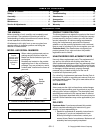GB - 6
Avoid uneven or rough terrain. DO NOT operate near
drop offs, ditches, or embankments. Unit can suddenly
turn over if a wheel is over the edge of a cliff or ditch, or if
an edge caves in.
Dust, fog, etc. can reduce vision and cause an accident.
Operate unit only when there is good visibility and light.
Data indicates that operators, age 60 and above, are
involved in a larger percentage of riding mower related
injuries. These operators should evaluate their ability to
operate the riding mower safely enough to protect
themselves and others from serious injury.
Only trained adults may operate unit. Training includes
being familiar with controls and actual operation.
NEVER operate unit after or during the use of
medication, drugs or alcohol.
NEVER allow anyone to operate this unit when their
alertness or coordination is impaired.
Wear adequate safety gear, sturdy shoes, and protective
gloves.
DO NOT wear loose clothing or jewelry and tie back hair
that may get caught in rotating parts.
Protect eyes, face and head from objects that may be
thrown from unit. Wear appropriate hearing protection.
Always wear safety goggles or safety glasses with side
shields when operating mower.
Avoid sharp edges. Sharp edges can cut. Moving parts
can cut off fingers or a hand.
ALWAYS keep hands and feet away from all rotating
parts during operation. Rotating parts can cut off body
parts.
ALWAYS keep hands away from all pinch points.
DO NOT touch unit parts which might be hot from
operation. Allow parts to cool before attempting to
maintain, adjust or service.
NEVER place your hands or any part of your body or
clothing inside or near any moving part while unit is
running.
NEVER direct discharge towards persons or property.
Thrown objects may ricochet back towards
operator.ALWAYS stand clear of the discharge area.
ALWAYS disengage attachment, stop unit and engine,
remove key, engage parking brake, and allow moving
parts to stop before leaving operator’s position.
Use extreme caution on gravel surfaces.
Disengage PTO when attachment is not in use and when
crossing gravel surfaces.
DO NOT operate unit if safety interlock system is
damaged or disabled. Check safety interlock before each
use (see
Operation
on page 8).
ALWAYS remove key to prevent unauthorized use.
DO NOT operate at too fast a rate. Slow down before
turning.
Stop engine before removing grass catcher or unclogging
chute.
DO NOT mow on wet grass. Reduced traction could
cause sliding.
DO NOT try to stabilize the machine by putting your foot
on the ground.
Know the weight of loads. Limit loads to those you can
safely control and the unit can safely handle.
ALWAYS keep protective structures, guards and panels
in good repair, in place and securely fastened.
Do not operate without either entire grass catcher or the
discharge guard in place.
DO NOT operate in reverse unless absolutely necessary.
ALWAYS look down and behind before and while
backing; especially for children.
Follow the manufacturer’s recommendations for wheel
weights or counterweights to improve stability when using
attachments.
NEVER carry passengers–especially children–even with
blades off.
Use extra care when approaching blind corners or
objects that may obscure vision of hidden obstacles and
children.
If you cannot back up a slope or you feel uneasy on it, do
not mow it.
Mow up and down slopes, not across them.
Use slow speed on any slope. Tires may lose traction on
slopes even though the brakes are functioning properly.
Keep all movements on the slope
slow
and
gradual.
DO
NOT make sudden changes in speed or direction.
Use extra care while operating machines with grass
catcher or other attachments. They can affect stability of
the machine.
Avoid starting, stopping, or turning on a slope. If tires lose
traction, disengage the blades and proceed slowly
straight
down the slope.
DO NOT operate on slopes over 10˚.
DO NOT park on slopes unless necessary. If unit is
parked on a slope, ALWAYS chock or block wheels and
set parking brake.
DO NOT disengage or bypass transmission and coast
downhill.
Tow only with a machine that has a hitch designed for
towing. Do not attach towed equipment except at the
hitch point.
Follow the manufacturer’s recommendations for weight
limits for towed equipment and towing on slopes.
NEVER allow children or others in or on towed
equipment.
On slopes, the weight of the towed equipment may cause
loss of traction and loss of control.
Travel slowly and allow extra distance to stop.
Use extra care when loading or unloading unit onto trailer
or truck.
Secure unit chassis to transport vehicle. NEVER secure
from rods or linkages that could be damaged.


















